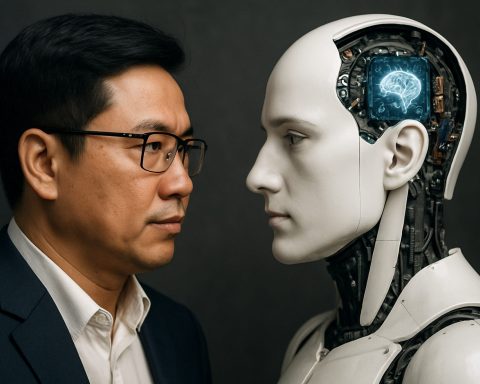- Duolingo is integrating artificial intelligence into its operations under CEO Luis von Ahn’s leadership, positioning AI as essential for growth.
- Five strategic principles guide this transition, focusing on reducing external collaborations and leveraging AI in recruitment and employee assessments.
- By 2024, Duolingo’s reliance on external content partners decreased by 10% due to AI integration, demonstrating a shift toward greater automation.
- The core team remains secure as AI enables rapid content scaling to meet diverse learner needs, enhancing educational effectiveness.
- AI innovations are reflected in products like the AI-driven chatbot Lily and have positively impacted Duolingo’s stock value, which increased by 68% in the past year.
- Duolingo’s approach, embracing both technology and diversification in learning areas, sets a future-oriented precedent for educational platforms.
Duolingo, the widely acclaimed language learning platform, is paving a new pathway, boldly intertwining artificial intelligence into its operations. At the helm, CEO Luis von Ahn is steering the company with an audacious shift towards an AI-driven future, a move he has candidly shared with employees through a LinkedIn memo.
Embracing Technology
Von Ahn’s vision casts AI as the fulcrum of growth for Duolingo. With a steadfast belief that waiting for technology to reach perfection isn’t an option, he emphasizes seizing the technological crown before it slips away. This tech-forward approach doesn’t shy away from experimentation, preferring to take bold steps, even if they come with slight imperfections in the quality of offerings. Such a strategy ensures Duolingo stays at the forefront of innovation, continually enhancing user experience and educational effectiveness.
The quintessence of this AI-focused metamorphosis is defined by five strategic principles. These include phasing out external collaborations for tasks AI can handle, harnessing AI within recruitment processes, evaluating AI’s role in employee performance assessments, approving new hires solely when automation isn’t feasible, and redefining operations through targeted AI initiatives.
Revolutionizing Operations
Duolingo’s embrace of AI has heralded transformative changes. By 2024, the company significantly reduced its reliance on external partners, trimming down by 10% due to integrating AI in content creation. The trajectory echoes a similar turn in 2023, marking a consistent pivot towards automation.
Importantly, von Ahn reassures that the core team remains safe under this evolving regime. He underscores AI’s pivotal role in rapidly scaling content to meet the diverse needs of learners worldwide, a feat unimaginable in a pre-AI era.
Innovation in Action
Reflecting its futuristic outlook, Duolingo showcases AI’s symbolic and practical applications. In a recent financial briefing, participants met Lily, a chatbot driven by artificial intelligence, subtly hinting at the broader role AI may soon play in executive duties. With tongue-in-cheek, von Ahn humorously remarked that one day Lily might take over more of his tasks, granting him an early retirement.
The market seems to have responded positively to this AI-infused strategy. Duolingo’s stock value has soared by 68% in the past year, a testament largely owed to the rise of subscription models and a diversification strategy that includes fresh learning categories such as chess and music.
Through this blend of innovative foresight and technological adaptation, Duolingo is crafting an educational landscape where AI doesn’t just assist but enhances every learning journey. This pioneering spirit not only promises continual growth but also sets a precedent, challenging educational platforms to evolve with the digital tide. In an ever-globalizing world, Duolingo’s AI-first strategy may well be the blueprint for the next wave of learning solutions.
How Duolingo’s AI Revolution is Transforming Language Learning
Duolingo’s Bold AI Integration: What You Need to Know
Duolingo’s shift towards an AI-driven framework has been groundbreaking, setting the company on a path to not only redefine how languages are learned but also how the education sector views technology as a whole. Below, we delve into elements not fully explored in the source material, including real-world applications, potential challenges, and future implications of this AI-embraced strategy.
Expanding Through AI: Key Facts and Market Insights
1. AI in Content Creation:
– Duolingo’s use of AI in content creation has allowed the platform to quickly adapt and present lessons tailored to individual learning paces. This personalized approach is akin to human-led tutoring, but at a significantly reduced cost, making high-quality education more accessible.
– Industry trends suggest that personalized AI-driven learning experiences could increase engagement and retention rates by up to 30% (Forbes).
2. Impact on Employment and Operations:
– AI’s role in streamlining operations at Duolingo raises questions about future workforce dynamics. By using machine learning to analyze employee performance and hiring processes, Duolingo could see more efficient HR practices. However, this also leads to ethical considerations regarding data privacy and employee trust.
– The broader market trend aligns with increased AI in HR management, as companies see a 26% efficiency gain in recruitment workflows (Gartner).
3. Diversification and Market Growth:
– Duolingo has diversified beyond languages to include other learning subjects like chess and music, potentially setting a precedent for further “edutainment” expansions.
– The global e-learning market size is projected to reach $457.8 billion by 2026, and companies like Duolingo are well-positioned to capture significant market share (ResearchAndMarkets).
Real-World Use Cases
– Education Sector: Schools and universities can incorporate AI-driven platforms for supplemental learning, allowing educators to focus on fostering critical thinking and interactive discussions.
– Corporate Training: AI-driven language training programs can be incorporated into corporate L&D ecosystems to provide scalable, global solutions for employee skill enhancement.
Exploring Potential Challenges
– Data Privacy Concerns: With AI handling significant amounts of user data, ensuring robust data protection strategies are crucial. Mishandling could lead to trust issues and legal challenges.
– Quality Control: AI methodologies are not foolproof, and reliance on automated systems may occasionally lead to errors or misinterpretations in content delivery.
Reviews and Comparisons
– In comparison with other language-learning apps like Rosetta Stone and Babbel, Duolingo’s free access and interactive AI-driven elements offer a unique blend of engagement and education at scale.
Actionable Recommendations
– Stay Updated on Learning Trends: Regularly updating skills and adapting to new technologies is crucial for learners and educators. Subscribe to Duolingo to keep abreast of AI advancements and new learning modules.
– Secure Personal Data: For individual users, ensure data settings are properly configured within the platform for optimal security.
By integrating AI into its core operations, Duolingo is not just pioneering a shift in educational tech but also prompting institutions and individuals to rethink learning strategies for the 21st century. As AI continues to evolve, so too does the promise of a dynamic and inclusive learning environment for all.





